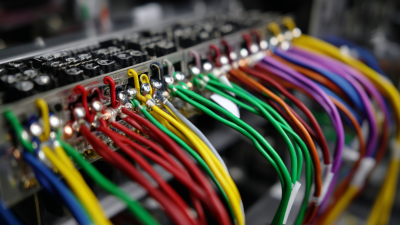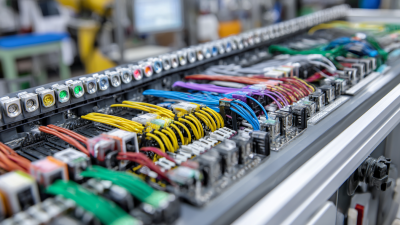What is a Cable Wire Harness and How Does It Power Modern Innovations?
In today's rapidly advancing technological landscape, the role of a cable wire harness has become increasingly critical. These intricate assemblies of wires, connectors, and protective coverings serve as the backbone of modern innovations, facilitating seamless communication and power distribution in a variety of applications, from automotive electronics to sophisticated industrial machinery. As devices grow more complex and interconnected, understanding the design and functionality of cable wire harnesses is vital for engineers and manufacturers alike. This guide will delve into the essential components of cable wire harnesses, their manufacturing processes, and the pivotal role they play in powering innovations that shape our daily lives. Join us as we explore how these seemingly simple components are integral to the technology that drives our world forward.

Understanding the Basics of Cable Wire Harnesses: A Comprehensive Overview
Cable wire harnesses are intricate assemblies of wires, connectors, and terminals that facilitate the transmission of electrical power and signals within various devices and systems. They are essential components in numerous modern innovations, from automobiles to consumer electronics, and play a pivotal role in enhancing connectivity and efficiency. According to a report by MarketsandMarkets, the global cable harness market is projected to reach $25.71 billion by 2026, driven by increasing demand in sectors like automotive, aerospace, and telecommunications.
In understanding the basics of cable wire harnesses, it's important to note the key factors that contribute to their effectiveness. A well-designed harness minimizes electrical interference and maximizes durability through suitable materials and insulation techniques. Additionally, it aids in simplifying complex wiring setups, making maintenance and replacements more accessible. When choosing a cable wire harness, consider factors such as temperature ratings, environmental resistance, and the number of circuits required.
**Tips:** Always evaluate your specific application needs before selecting a wire harness. Custom designs can significantly improve performance and lifespan. Regular inspections of existing harnesses can catch potential issues early, ensuring system reliability and safety.
Impact of Cable Wire Harnesses on Different Industries
Key Components and Materials Used in Cable Wire Harness Manufacturing
A cable wire harness is essential in various applications, integrating multiple wires and cables into a single unit for efficient connectivity. Among the key components in cable wire harness manufacturing, connectors, terminals, and protective coverings play vital roles. Connectors facilitate secure connections between electronic devices, while terminals ensure proper electrical flow. Additionally, the choice of protective coverings, such as heat shrink tubing or conduits, enhances durability against environmental factors.
When designing a cable wire harness, selecting the right materials is crucial. High-quality conductors, such as copper or aluminum, ensure optimal electrical conductivity, while insulation materials like PVC or polyethylene provide necessary protection against shorts and wear.
**Tip**: Always consider the operating environment when choosing materials; factors such as temperature range and exposure to chemicals can significantly impact performance.
Furthermore, customization is often needed to meet specific requirements of modern innovations in sectors like automotive or aerospace. Incorporating features like strain reliefs and custom-length cables can improve the harness's overall reliability.
**Tip**: Engage with manufacturers early in the design process to ensure that your cable wire harness meets both technical specifications and cost-effectiveness.
What is a Cable Wire Harness and How Does It Power Modern Innovations?
| Component Type | Material Used | Purpose | Applications |
|---|---|---|---|
| Connector | Polyamide (Nylon) | Electrical connection | Automotive, Aerospace |
| Cable | Copper | Electrical conductivity | Consumer Electronics, Industrial Machinery |
| Insulation | PVC (Polyvinyl Chloride) | Safety & insulation | Telecommunications, Automotive |
| Heat Shrink Tubing | Polyolefin | Protection & insulation | Medical Devices, Aerospace |
| Backing Material | Polyethylene | Support & structure | Automotive, Robotics |
The Role of Cable Wire Harnesses in Automotive and Aerospace Innovations
Cable wire harnesses play a pivotal role in the automotive and aerospace industries, serving as the backbone for electrical systems that drive modern innovations. In automobiles, these harnesses facilitate the connection between various electronic components, allowing for efficient communication and control. Advanced driver-assistance systems (ADAS), infotainment features, and electric powertrains all rely heavily on intricate wiring layouts that optimize performance and safety. By organizing and protecting the wires, harnesses help to minimize failures and enhance the longevity of the vehicle's electronic systems.
In the aerospace sector, cable wire harnesses are equally essential. They ensure reliable power distribution and data transmission across complex aircraft systems. Given the stringent safety regulations and the critical nature of aerospace operations, harnesses are engineered with precision and tested rigorously for durability and resistance to environmental factors. With the push towards more electric aircraft and the incorporation of sophisticated automation systems, the role of cable wire harnesses has become increasingly significant, providing the necessary infrastructure to support these technological advancements. Their ability to withstand harsh conditions while maintaining efficiency makes them an indispensable element in both automotive and aerospace innovations.

How Cable Wire Harnesses Enhance Efficiency in Modern Electronic Devices
Cable wire harnesses play a crucial role in enhancing the efficiency of modern electronic devices by organizing and protecting critical wiring systems. These harnesses bundle multiple wires into a single unit, which streamlines installation and reduces clutter. By minimizing the risk of tangling and damage, they not only ensure reliable connections but also facilitate faster assembly in manufacturing processes. This organization leads to significant time savings and lowers production costs, making electronic devices more accessible and affordable for consumers.
Additionally, cable wire harnesses contribute to improved performance and longevity of electronic devices. Their robust construction often includes heat resistance and environmental protection, safeguarding internal wiring from external elements that could cause shorts or failures. In high-stress applications, such as automotive or aerospace technology, the harnesses are designed to withstand vibrations and other mechanical impacts. As a result, integrating high-quality cable wire harnesses into electronic systems not only boosts efficiency during the production phase but also enhances the device's overall durability and reliability in day-to-day use, fostering greater consumer trust and satisfaction.
Trends and Future Developments in Cable Wire Harness Technology and Applications
The cable wire harness industry is experiencing significant trends and future developments, driven by the rising demand for enhanced connectivity in various sectors, including automotive, aerospace, and consumer electronics. According to a report by MarketsandMarkets, the global cable harness market is projected to grow from USD 69.5 billion in 2021 to USD 98.7 billion by 2026, reflecting a compound annual growth rate (CAGR) of 7.4%. This growth is largely attributed to the increasing complexity of electronic systems, necessitating more sophisticated harness solutions that ensure reliable power distribution and signal transmission.
Emerging technologies are also shaping the future of cable wire harnesses. The integration of smart technologies, such as Internet of Things (IoT) devices and advanced manufacturing processes like 3D printing, allows for customized and lightweight harness designs. Moreover, with the automotive industry's shift toward electrification, cable harness designs are evolving to support high-voltage applications while maintaining efficiency and safety. Research by Mordor Intelligence indicates that the electric vehicle segment alone is expected to grow at a CAGR of over 20% between 2021 and 2026, emphasizing the pivotal role that innovative cable harnesses will play in supporting this transition. As these trends continue, the industry is expected to focus on developing sustainable materials and manufacturing methods, aligning with the broader goal of reducing environmental impact.

Related Posts
-

The Definitive Ultimate Guide to Mastering Wire Harness Assembly for Optimal Performance
-

The Ultimate Guide to Streamlining Your Harness Assembly Process for Maximum Efficiency
-

5 Essential Reasons Your Business Needs a Reliable Cable Harness Supplier
-

Challenges Faced in Cable Harness Design Efficiency
-

What Is the Future of Wire Harness Manufacturing Equipment
-

Explore Superior Wire Harness Assembly Solutions from Leading Chinese Manufacturers